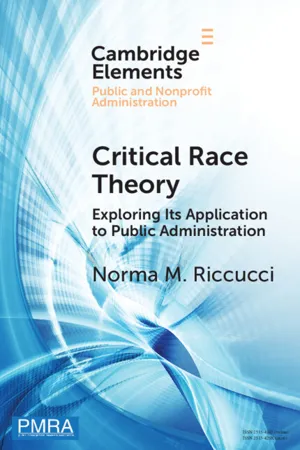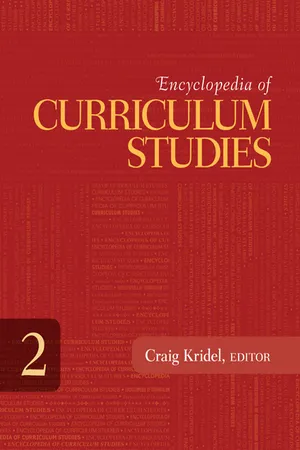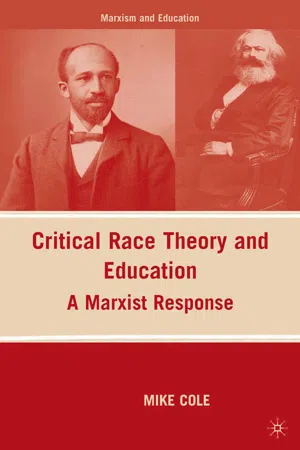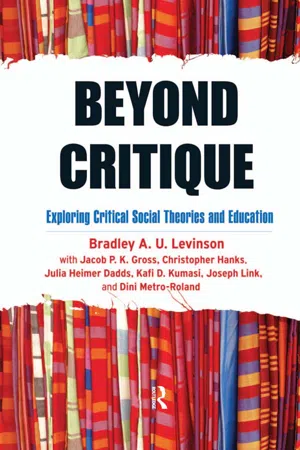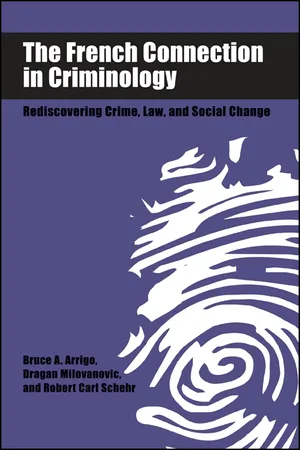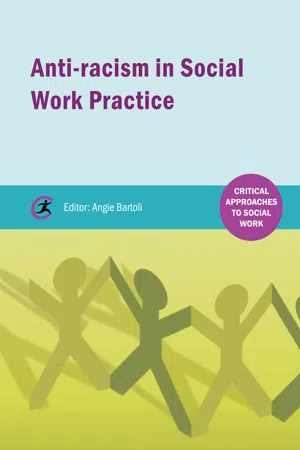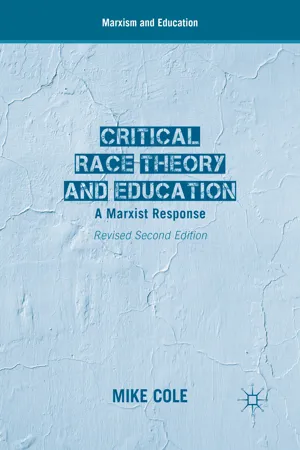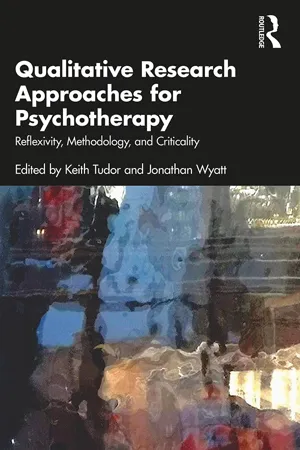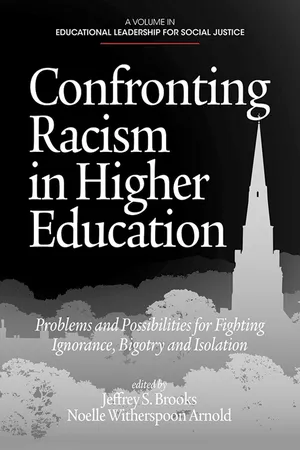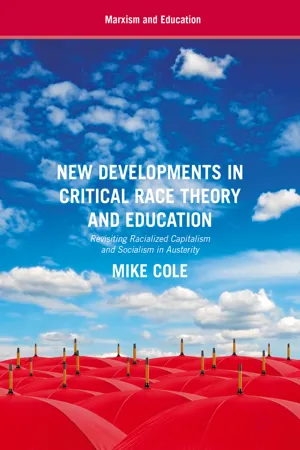Literature
Critical Race Theory
Critical Race Theory is a framework that examines how race and racism intersect with social, legal, and political structures. It challenges the idea of colorblindness and emphasizes the importance of understanding how systemic racism operates. It also seeks to uncover and address the ways in which racial power dynamics shape society and impact individuals' experiences.
Written by Perlego with AI-assistance
Related key terms
1 of 5
12 Key excerpts on "Critical Race Theory"
- Samuel Totten, Jon Pedersen(Authors)
- 2013(Publication Date)
- Information Age Publishing(Publisher)
Educating About Social Issues in the 20th and 21st Centuries, pages 53–70 Copyright © 2014 by Information Age Publishing All rights of reproduction in any form reserved. 53 CHAPTER 3 Critical Race Theory IN EDUCATION Laura Quaynor and Timothy Lintner WHAT IS Critical Race Theory? Critical Race Theory (CRT) is premised on the notion that select machina- tions of American society—the legal and educational systems in particular— foster political benefits for whites and assuage the racial underpinnings of a predominantly racist white America (Chandler, 2010). Though there is no patent doctrine to which all scholars of CRT adhere, there are some common definitional parameters that have come to shape both theory and practice. Five of the most significant parameters shall be delineated here. First, racism and racial inequality are endemic to American society (Del- gado, 1995). Such racial inequalities can be found in, amongst others, in- terpersonal relationships sought (or avoided), neighborhoods inhabited, and schools attended (Zamudio, Russell, Rios, & Bridgeman, 2011). These, and other “racial choices,” have created a natural, subliminal acceptance of race and racial spaces. The role of CRT is to unravel and ultimately unmask the various permutations of racism. Second, CRT challenges notions of neutrality, objectivity, and color blind- ness. Hartlep (2009) argues that such constructs serve to minimize white 54 L. QUAYNOR and T. LINTNER responsibility for the struggles of people of color. In doing so, opinions and assumptions are made devoid of the social context in which they reside. Third, CRT is historically based. Contemporary manifestations of race cannot be understood unless they are situated in historical contexts. Rac- ism did not “just appear.” From the Three-Fifths Compromise to Jim Crow, a read of the historical record reveals systemic and sustained examples of social, economic, and educational inequalities.- No longer available |Learn more
Blackness and la Francophonie
Anti-Black Racism, Linguicism and the Construction and Negotiation of Multiple Minority Identities
- Amal Madibbo(Author)
- 2021(Publication Date)
- Presses de l'Université Laval(Publisher)
11 CHAPTER 1 – INTRODUCTION THEORETICAL FRAMEWORK Critical Race Theory The term “critical” refers to an ideology and an activity (Madison 2012). With regard to ideology, it signifies anti-oppression and anti-subordination knowledge that seeks to achieve human liberation. In term of activity, it encapsulates actions that aim to accomplish social justice, and these actions range from thinking modest thoughts or making suggestions to political activism (Ladson-Billings & Tate 1995). Critical Race Theory (CRT) embra-ces the critical approach inasmuch as it merges anti-oppressive theory with praxis to pursue social justice (Martinez 2014). Scholars of colour, mostly Blacks, developed CRT in American law schools in the late 1980s, con-tending that the law should be improved because it serves to maintain racism. Such transformation is needed to effect positive change in the lives of racialized people. The theory then extended to numerous disciplines and has been used to analyze various social problems in many regions and countries. [CRT] combines social activism with a critique of the fundamental role played by White racism in shaping contemporary societies . . . . [It] has its roots in the centuries-old diasporic experiences and struggles of people of color, especially enslaved Africans and their descendants in the US. The perspective builds on this tradition in numerous ways, including the central role it devotes to political struggle, its concern for storytelling, and the significant position accorded to key Black intellectual figures of the nineteenth and twentieth centuries such as Frederick Douglass and W. E. B. Du Bois (Gillborn & Ladson-Billings 2010, 40-41). Critical race theorists believe . . . [that] racism is ordinary, not aberra -tional . . . color-blindness . . . can thus remedy only the most blatant forms of discrimination . - eBook - PDF
Critical Race Theory
Exploring Its Application to Public Administration
- Norma M. Riccucci(Author)
- 2022(Publication Date)
- Cambridge University Press(Publisher)
hooks 1995, Killing Rage: Ending Racism Introduction Critical Race Theory (CRT) is a framework that adopts a race-conscious approach to uncover and better understand institutional and structural racism in our society with the aim of promoting and achieving social justice. The premise of CRT is that our legal, political, and economic institutions are inherently racist and that race is a socially constructed concept that enables and justifies the ability of Whites to promote their own economic, social, and political interests at the expense of people of color (Bell, 1992, 1995; Crenshaw, 1988). 1 Bell and other legal scholars advanced the theory in the 1970s and 1980s in response to the lack of or incremental progress being made by the civil rights movement, arguing that White liberal ideals such as equal opportunity, freedom of choice, and merit advanced the interests, privileges, and entitlement of Whites while perpetually repressing and oppressing people of color. Initially relied upon in legal studies as a framework to analyze patterns in law, court cases, and legal precedents, CRT more recently has been applied to a number of disciplines, including sociology (Bonilla-Silva, 2015; Ray et al., 2017; Romero, 2001), social work (Moore et al., 2018), criminology (Coyle, 2010; Cunneen and Tauri, 2019; Schneider, 2003), social psychology (Correll et al., 2007; Kang et al., 2012), public health (Gilbert and Ray, 2016), and predominantly education (Banks, 1995; Garcia, López, and Vélez, 2017; Ladson-Billings, 1999; Sablan, 2019). 2 Research has employed both qualitative and quantitative methodologies, although a number of provisos have been advanced around the application and suitability of quantitative methods. This Element addresses these issues in the context of public administration research, and proposes areas within the field that could benefit from the appli- cation of a CRT framework. - eBook - PDF
- Craig Kridel(Author)
- 2010(Publication Date)
- SAGE Publications, Inc(Publisher)
Boston: South End Press. Pinar, W. F. (2004). What is curriculum theory? Mahwah, NJ: Lawrence Erlbaum. C RITICAL R ACE T HEORY Over the past 15 years, Critical Race Theory (CRT) has been utilized as a tool in the structural analy-sis of K–16 education in the United States and internationally and a basic construct in curricu-lum studies. As an interdisciplinary method with the aim of analyzing and addressing issues of race and racism in education, CRT incorporates con-structs from the disciplines of ethnic studies, women’s studies, legal theory, philosophy, sociol-ogy, and history. Although not limited to the aforementioned disciplines, CRT scholars have recently expanded its reach to the fields of urban planning, public health, and medicine. Origins Responding to the critical legal studies (CLS) move-ment in legal scholarship, CRT was the attempt by legal scholars of color to critique liberalism. The CLS scholars understood the legal system to be unjust with regard to issues of class, but CRT scholars felt that it did not take into account all the necessary evils that contributed to an unjust soci-ety. Challenging their primary focus on class, CRT scholars felt it was just as important to incorporate race as one of the evils that contribute to an unjust legal system. Their understanding was that racism will not go away because just because CLS scholars argue that the law is reflective of the interests of the power structure. Instead, CRT scholars operated on the premise that social reality is constructed through narrative. In creating such an exchange, narrative becomes the compound agent that embraces an interdisciplinary approach. To the CRT scholar, the theoretical construct expands the scope of CLS through the addition of a racial com-ponent by way of critique of the liberal tradition in legal scholarship. From the legal perspective, there are three com-ponents of CRT that are relevant to the analysis of race and racism in education and curriculum stud-ies. - eBook - PDF
Critical Race Theory and Education
A Marxist Response
- M. Cole(Author)
- 2009(Publication Date)
- Palgrave Macmillan(Publisher)
The organizers, principally Kimberlé Crenshaw, Neil Gotanda, and Stephanie Philips, coined the term ‘Critical Race Theory’ to make it clear that their work was located in the ‘intersection of critical theory and race, racism and the law’. This workshop featured a couple days of discussion aimed at find- ing out whether all the participants shared a common core of principles and ideas, and if so which ones. The ideas in Crenshaw’s influential paper enti- tled ‘Race, Reform and Retrenchment: Transformation and Legitimization in Antidiscrimination Law’, which had been published in the Harvard Law Review in 1988 were central to these discussions. By the mid-1990s, according to leading Critical Race Theorist, Gloria Ladson-Billings (2005, p. 57) legal scholars had written more than 300 lead- ing law review articles and a dozen books on CRT. Cementing the pivotal relationship between CRT and law, a pioneering (1995) article by Ladson-Billings and William Tate traces the development of what they refer to as the Property Issue in the United States. This, they note to be a defining feature of the society encompassing a sequence of Critical Race Theory 15 exploitative events which began with the removal of native Americans from the land, continued through military conquest of the Mexicans to the con- struction of Africans as property. Ladson-Billings and Tate begin by stating that racism is endemic and deeply ingrained in American life and that the cause of African-American underachievement is ‘institutional and structural racism’ (Ladson-Billings and Tate, 1995, p. 55). They then go on argue that segregation continues in U.S. schools with African-American and Latino/a students still faring badly as compared to white students. Following Delgado et al. (1989), they argue that the dominant group justifies its power with stories that ‘construct reality in ways to maintain their privilege’ (Ladson-Billings and Tate, 1995, p. 58). - eBook - ePub
Beyond Critique
Exploring Critical Social Theories and Education
- Bradley A. Levinson, Jacob P. K. Gross, Christopher Hanks, Julia Heimer Dadds, Kafi Kumasi, Joseph Link(Authors)
- 2015(Publication Date)
- Routledge(Publisher)
The chapter is organized into five sections. The first section provides contextual remarks to help situate current discussions of race and education in the twenty-first century. The second section highlights the intellectual precursors to CRT, beginning with anticolonial thinkers and protesters from around the world. The third section traces the development of CRT with its origins as a counterlegal discourse that took root in the United States during the civil rights era; it offers a brief discussion of the multicultural intellectual genealogy of CRT. The fourth section contains definitions of key CRT concepts that have been highlighted throughout the chapter in italics. The fifth and final section provides a brief introduction to CRT in education, followed by a close examination of two articles that exemplify how educational scholars are using CRT to address contemporary issues, particularly as they relate to research and teaching.Contextualizing Race and Education
It is fashionable nowadays to downplay and even dismiss race as a factor shaping the quality of life in the United States and instead to favor class-based and gender-based approaches to understanding social oppression.—Garrett Duncan, Critical Race Theory and MethodOver the last twenty years or so, one can discern a disturbing trend in mainstream educational discourses regarding how school inequities are explained. The tendency is to attribute the disparities that exist between inner-city and suburban school resources and between achievement among white and non-white youth to issues of class, while dismissing or minimizing the influence of racism. There is a sense that racism has been eradicated in the post–civil rights era and that racially subordinated peoples rely too much on “racial victimology” (McWhorter 2000 ) to explain their own social conditions. Author and cultural critic Shelby Steele has also written extensively about the notion of racial victimology in his bookWhite Guilt: How Blacks and Whites Together Destroyed the Promise of the Civil Rights Era - eBook - PDF
The French Connection in Criminology
Rediscovering Crime, Law, and Social Change
- Bruce A. Arrigo, Dragan Milovanovic, Robert Carl Schehr(Authors)
- 2012(Publication Date)
- SUNY Press(Publisher)
In this chapter, we suggest some possible integrations of first and second wave French postmodern social theory with Critical Race Theory. As such, we argue for the development of additional insights relevant to the forms, bases and effects of racism, impeding progressive social change practices. Accordingly, we concentrate on three areas: storytelling and narrative con- struction; the wherewithal of subjectivity, particularly its intersectional forms; and an alternative, nontraditional methodology for understanding and for transpraxis. However, before we proceed, some provisional background material on CRT and what it signifies are in order. Critical Race Theory: AN OVERVIEW The core Critical Race Theory concepts have been articulated 3 by Delgado and Stefancic (2001, 6–9): 1. that racism is ordinary, not aberrational . . . the usual way society does its business . . . 2. our system of white-over-color . . . serves important purposes [functions], both psychical and material . . . 3. race and races are products of social thought and relations . . . races are categories that society invents, manipulates, or retires when convenient. Given the progressive orientation delineated above, we note that CRT goes well beyond more traditional civil rights analysis. Indeed, it critiques such things as formal equality before the law, neutral principles in law, and legal reasoning and rationalism (2001, 3). Moreover, CRT focuses on under- standing forms of oppression as well as actively seeking to change them. One dimension of this is the emergence of new CRT theories. Indeed, just as the formal beginnings of CRT could be traced to a differentiation within critical legal studies and the criticisms developed by feminist jurisprudence, we also note further differentiation with the development of LatCrit (latino/a), theory, queer-crit theory, and Asian-American studies. - No longer available |Learn more
- Angie Bartoli(Author)
- 2013(Publication Date)
- Critical Publishing(Publisher)
(Bell, 1992 , p 13) Bell’s chronicle has been described as a classic Jeremiad – a tale aimed at making a powerful group aware of its own iniquitous history and potential for more of the same. It aims at kindling conscience and jarring complacency (Delgado and Stefancic, 1991 , p 324). CRT has sometimes been described as a rather pessimistic or depressing theory, and sometimes it can seem so as it does not present a rosy, liberal, easy, linear or comfortable view of progress in pursuit of racial equality. It also does not underestimate the resistance of white people to voluntarily give up their relative racial privilege and power. However, CRT can also be seen as liberating and providing hope in the realisation that the continued existence of racism is not a result of failures by anti-racists and racism can be defeated and overcome by collective endeavour. I have found CRT gives me a perspective on understanding racism that is both intellectually challenging, offers explanations of a complex phenomena and a theory for action, change and eventual liberation – both for white and black people. an overview of some of the key themes of CRT has helpfully been supplied by Professor David Gillborn (Gillborn, 2008 , p 40). Some of these will be considered in more detail later in this chapter. Critical Race Theory: a conceptual map Key themes • Racism as endemic : racism as so extensive that it is normal (in the sense that it is often found – not normal in any moral or evaluative sense), not aberrant nor rare; ‘race’ is viewed as socially constructed and constantly changing. • Critique of liberalism : views claims of neutrality, objectivity, colour-blindness and meritocracy as camouflages; formal equal opportunities laws as too limited in scope. • Revisionist critique of civil right laws : identifying the limits of progress to date and the means by which apparent advances have been clawed back. - eBook - PDF
Critical Race Theory and Education
A Marxist Response
- Mike Cole(Author)
- 2017(Publication Date)
- Palgrave Macmillan(Publisher)
This might include equalizing all salaries in the school, including secretaries and janitors, and everyone spending one month per year per- forming a job in a different part of the hierarchy (ibid., p. 615). Kennedy aims to help the students organize against the authoritarian classroom; for curriculum change to reduce Right-wing political bias and its incapacity for alternative forms of practice; and to establish politically sensitive legal services clinics for poor people, operated by the law school (ibid., p. 612). 6 Critical Race Theory: THE BEGINNINGS As Crenshaw et al. (1995b, p. xix) explain, Critical Race Theory (CRT) emerged in the interstices of the political and institutional dynamic created by the disintegration of the center ground, and represented an attempt to inhabit the space between two very different ideological and intellectual formations. First, Critical Race Theory (CRT) was a reaction to Critical Legal Studies, criticizing CLS for its undue emphasis on class and eco- nomic structure, and insisting that ‘race’ is a more critical identity. As Cornel West (1995, p. xi) puts it, ‘critical legal studies writers … “decon- structed” liberalism, yet seldom addressed the role of deep-seated racism in American life’. Second, CRT ‘sought to stage a simultaneous encounter with the exhausted vision of reformist civil rights scholarship’ (Crenshaw et al. 1995b, p. xix), its liberal tradition having directly impinged on the lived experiences of people of color in the law schools (ibid.). As Crenshaw et al. (ibid.) put it: We both saw and suffered the concrete consequences that followed from liberal legal thinkers’ failure to address the constrictive role that racial ideol- ogy plays in the composition and culture of American institutions, including the American law school. - eBook - ePub
Qualitative Research Approaches for Psychotherapy
Reflexivity, Methodology, and Criticality
- Keith Tudor, Jonathan Wyatt, Keith Tudor, Jonathan Wyatt(Authors)
- 2023(Publication Date)
- Routledge(Publisher)
2022 ). We see CRT as a framework that can bring an epistemological lens to a social justice agenda in research.In the following section, we outline some tenets of CRT and illustrate the importance of exposing racism in psychotherapy research. This is a way in which both a critical consciousness and an evidence base can be established in our profession that embed equity in the perspectives of people of colour in research and transformative psychotherapy practices.Critical Race Theory
The movement that led to the development of CRT began in the post-civil rights era as schools were being desegrated. CRT is based upon the critical theory of legal scholars and assesses how institutions, such as criminal justice, education, the housing market, healthcare, and labour market institutions, have unequal practices (Delgado & Stefancic, 2001, 2012). The application of CRT practice can be extended to critiquing inequality and racism in psychotherapy and other forms of trauma for people of Indigenous backgrounds. Drawing on the work of some CRT scholars, we summarise some of the themes found in CRT and illustrate them with reference to the psychological and social psychology sphere (Delgado & Stefancic, 2001, 2012; McDowell & Jeris, 2004 ):- Challenging the belief that racism is normal or ordinary and the argument that race is socially constructed and not biologically natural.
- Focusing on what CRT scholars call ‘interest convergence’ or ‘material determinism’, the argument is that legal advances (or setbacks) for people of colour tend to serve the interests of dominant white groups. Thus, the racial hierarchy that characterises Western and European societies may be unaffected or even reinforced by ostensible improvements in the legal status of oppressed or exploited people.
- CRT values the notions of intersectionality and anti-essentialism, which argue that no individual can be adequately identified by membership in a single group. An African American or Black British person, for example, may also identify as a woman, heterosexual, having a faith, and so on.
- eBook - PDF
- Jeffrey S. Brooks, Noelle Witherspoon-Arnold(Authors)
- 2012(Publication Date)
- Information Age Publishing(Publisher)
Legal and Educational Foundations in Critical Race Theory 131 minority participants’ familiarity with racial oppression and ostracization. To engage in discourse about White racism when either the researchers or the participants is non-White may raise issues of power and positionality. Would students of color in teacher preparation programs amplify their ra- cialized experiences so as to give White instructors what they would like to hear in order to receive a higher grade? Would White teachers in profes- sional development sessions trivialize minority scholars’ experiences with discrimination on account of their being overly sensitive to race issues? Even in the most ideal of circumstances where all participants reflected upon their racial experience with utmost candor, where power and posi- tionality did not influence the dynamics of the discussion, one would still have to acknowledge that a discourse that is centered on “blind racism” or “White privilege” among Whites would still be radically different from a discourse that is centered on “systemic racism” and “oppression” between people of color. This is perhaps why scholars of color find the dominant discourse on racism somewhat unsatisfactory. It continues to leave out the voices of the marginalized while glorifying the progress made by Whites. The use of CRT in raising the race consciousness of educators allevi- ates the problems noted above. First, the thematic nature of CRT readily lends itself to addressing the historical, social, and political context of race and racism in a methodical manner. A critique on the “endemic nature of racism” and the “myth of meritocracy” is rooted in legal and historical precedents, not merely on theoretical hypotheses or circumstantial inter- pretations. Rather than challenging the existence of White privilege as an amorphous entity, CRT provides concrete examples of how Whiteness has garnered unmerited benefits throughout U.S. - eBook - PDF
New Developments in Critical Race Theory and Education
Revisiting Racialized Capitalism and Socialism in Austerity
- Mike Cole(Author)
- 2017(Publication Date)
- Palgrave Macmillan(Publisher)
CRITICAL LEGAL STUDIES AND CRT Next in chapter 2 of Cole (2017), I address CRT’s historical origins in CLS in the USA. CLS, I note, was a response to the law’s role in protect- ing hierarchy and class. It was in essence a socialist movement, although many commentators on the movement, as is demonstrated in the chap- ter, tend to use the adjective ‘Left’ to describe it, perhaps to distinguish ‘socialism’ from Stalinism, the authoritarian distortion of socialism that many people in the USA are led to believe, incorrectly I would insist, is socialism’s only viable form. 1 Mark Tushnet, secretary of the Conference on Critical Legal Studies from 1976 to 1985, is unambiguous about his take on the revolutionary nature of CLS, when he writes that if he were to be asked to decide actual cases as a judge, he would ‘make an explicitly political judgement: which result is, in the circumstances now existing, likely to advance the cause of socialism?’ (Tushnet 1981, p. 424). His reasoning is that the courts, like the government, are unequivocally on the side of capitalism, and that therefore it is absolutely necessary to take sides. With respect to socialist practices in the workplace, Duncan Kennedy (1982, p. 615) notes how both Marxist and non-Marxist law teachers were attempting at the time to challenge the dominant mode of produc- tion and radicalize their work lives by equalizing all salaries, including secretaries and janitors, and everyone spending one month per year per- forming a job in a different part of the hierarchy. 14 M. COLE CRT was in part a response to the perception that the analyses of CLS were too class-based and underestimated the centrality of ‘race’, for them the major form of oppression in society. As Kimberlé Crenshaw and her co-writers (1995, p. xix) put it, Critical Race Theorists sought ‘a left inter- vention into race discourse and a race intervention into left discourse’.
Index pages curate the most relevant extracts from our library of academic textbooks. They’ve been created using an in-house natural language model (NLM), each adding context and meaning to key research topics.


